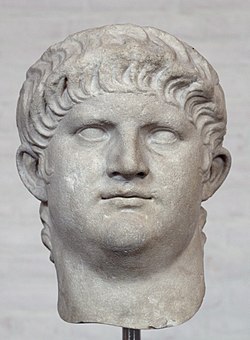Nero
Nero Claudius Caesar Augustus Germanicus (15 Desember 37 – 9 Juni 68)[1], lahir Lucius Domitius Ahenobarbus, juga disebut Nero Claudius Caesar Germanicus, adalah kaisar Romawi kelima dan terakhir dari dinasti Julio-Claudian. Nero diadopsi oleh pamannya, Claudius untuk menjadi penerus tahtanya. Ia naik tahta pada tanggal 13 Oktober 54 karena kematian Claudius.

Nero berkuasa dari tahun 54 sampai tahun 68, yang fokus lebih besar dengan diplomasi, perdagangan, dan meningkatkan budaya ibukota kekaisaran. Ia memerintahkan pembangunan teater dan permainan atletik. Kekuasaannya juga berhasil memenangkan perang dan berdamai dengan kekaisaran Parthian (58–63) dan menambah tali hubungan diplomasi dengan Yunani. Pada tahun 68, kudeta militer menurunkan Nero. Ia akan menghadapi eksekusi, dan ia dilaporkan bunuh diri.[2]
Kekuasaan Nero sering berhubungan dengan tirani dan kekejaman.[3] Ia telah melakukan beberapa eksekusi, termasuk ibunya[4] dan saudara kandung adopsinya, dan juga kaisar yang "membakar Roma"[5] dan pembunuh Kekristenan awal. Penglihatan ini dilihat berdasarkan referensi dari Tacitus, Suetonius dan Cassius Dio.
Catatan kaki
- ^ Nero's birth day is listed in Suetonius, The Lives of Twelve Caesars, Life of Nero 6. His death day is uncertain, though, perhaps because Galba was declared emperor before Nero died. A June 9th death day comes from Jerome, Chronicle, which lists Nero's rule as 13 years, 7 months and 28 days. Cassius Dio, Roman History LXII.3 and Josephus, War of the Jews IV, say Nero's rule was 13 years, 8 months which would be June 11th
- ^ Suetonius claims that Nero commited suicide in Suetonius, The Lives of Twelve Caesars, Life of Nero 49; Sulpicius Severus, who possibly used Tacitus' lost fragments as a source, reports that is was uncertain whether Nero commited suicide, Sulpicius Severus, Chronica II.29, also see T.D. Barnes, "The Fragments of Tacitus' Histories", Classical Philology (1977), p.228
- ^ Galba criticized Nero's luxuria, both his public and private excessive spending, during rebellion, Tacitus, Annals I.16; Kragelund, Patrick, "Nero's Luxuria, in Tacitus and in the Octavia", The Classical Quarterly, 2000, p. 494-515
- ^ References to Nero's matricide appear in the Sibylline Oracles 5.490-520, Geoffrey Chaucer's Canterbury Tales The Monk's Tale, and William Shakespeare's Hamlet 3.ii
- ^ Nero was not a fiddle player, but a lyre player. Suetonius claims Nero played the lyre while Rome burned, see Suetonius, The Lives of Twelve Caesars, Life of Nero 38; For a detailed explanation of this transition see M.F. Gyles "Nero Fiddled while Rome Burned", The Classical Journal (1948), p. 211-217 [1]
Referensi
- Tacitus, Histories, I-IV (c. 105)
- Tacitus, Annals, XIII–XVI (c. 117)
- Josephus, War of the Jews, Books II-VI (c. 94)
- Josephus, Antiquities of the Jews, Book XX (c. 94)
- Cassius Dio, Roman History, Books 61–63 (c. 229)
- Plutarch, The Parallel Lives, The Life of Galba (c. 110)
- Philostratus II, Life of Apollonius Tyana, Books 4–5, (c. 220)
- Suetonius, The Lives of Twelve Caesars, the Life of Nero (c. 121)